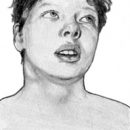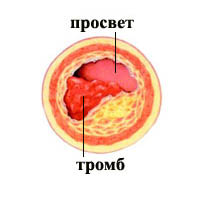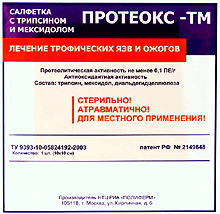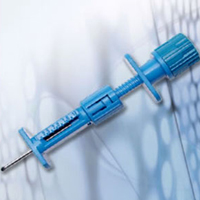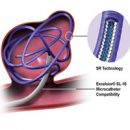Traumatic shock is a serious life threatening condition. Traumatic shock occurs in injuries or operations related to large blood loss. In the development of shock, erectile and trapid phase.
Content
Traumatic shock - severe, threatening life of a patient, arising in heavy injuries, operations that are accompanied by a large blood loss.
The main causes and mechanisms for the occurrence of traumatic shock
Distributed household expression «pain shock», «Death from pain». However, in reality «painful» There is no, and die from one pain - even very strong - a person can not. The true cause of the development of traumatic shock is the rapid loss of a large blood volume. Moreover, this loss may not be required in the form of an explicit (outer) or hidden (internal) bleeding, a shock state may cause a massive loss of blood plasma through the burned skin surface with burns.
Important for the development of traumatic shock has not so much the absolute value of blood loss, how much blood loss speed. With a quick blood loss, the body has less time to adapt and adapt, and the development of shock is more likely, that is why shock is more likely when the wounded of large arteries, for example, the femoral.
Silent pain, as well as neuropsychic stress associated with injury, undoubtedly play a role in the development of a shock condition (although they are not its main reason), and aggravate the severity of the shock.
The factors leading to the development of traumatic shock or aggravating it are injuries with damage to vital organs (for example, wound in the chest, fractures of the ribbies with a violation of the function of external respiration, the cranknaya injury). In such cases, the severity of the shock is determined not the size of blood loss and the intensity of pain syndrome, but by the nature of the injury and the degree of safety of the function of vital organs.
Fast and massive blood or plasmodotter lead to a sharp decrease in circulating blood volume. As a result, blood pressure drops quickly and strongly, the supply of tissues with oxygen and nutrients deteriorates, a tissue oxygen starvation develops. Due to the lack of oxygen tissues in them, toxic admissible metabolic products are accumulated in them, intoxication develops. Lacking glucose tissues and other nutrients leads to their transition to «self-sustaining» - Lipolysis (disintegration of fats) is enhanced.
The body, trying to cope with blood loss and stabilize blood pressure, reacts with a release in the blood of various vessels (in particular, adrenaline, norepinephrine, dopamine, cortisol) and peripheral vessels. It can temporarily stabilize blood pressure on relatively «acceptable» level, but at the same time further worsens the situation with the supply of peripheral tissues with oxygen and nutrients.
The outcome of a heavy shock without treatment is usually agony and death. In the case of a relatively notable or moderate severity of the shock, in principle, self-healing is possible.
Symptoms of traumatic shock
Traumatic shock usually passes in its development two phases, the so-called «erectile» Phase shoca I «Thorpid» phase. In patients with low compensatory capabilities of the body, the erectile phase of shock may be absent or being very short (measured by minutes) and shock begins to develop immediately from the trapid phase.
In the first, erectile, shock phase, sick is excited, frightened, anxious. He can rush, scream from pain, moan, cry, complain about pain, ask or demand analgesics, drugs.
In this phase, the compensatory capabilities of the body are not yet exhausted, and blood pressure is often even increased compared with the norm (as a reaction to pain and stress).
In the trapid phase of the shock, the patient ceases to shout, moan, cry, rushing from pain, does not ask anything, does not require. He is slowed down, badly, apatic, drone, depressive, can lie in complete prostration or losing consciousness. Arterial pressure decreases, sometimes to critical low numbers or is not determined at all when measured on peripheral vessels. The eyes of the patient with a trapid shock dull, losing shine, look out. Pupils are expanded. Temperature of the body may be normal, increased (joining the wound infection) or a bit lowered to 35.0-36.0 ?C («Energy exhaustion» fabrics). Draws attention to the sharp pallor of patients, the sinushesity (cyanoticity) of lips and other mucous membranes.
The phenomena of intoxication are noted - dry lips, baked, the language is very covered, the patient is tormented by a constant severe thirst, nausea. RVOT may be observed.
Medical activities at traumatic shock
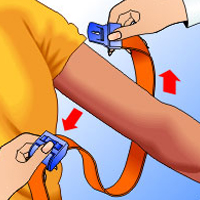 It should be tried as best and fully stopped bleeding, for this it is necessary to press a finger with a bleeding large vessel above the location of damage, impose a pressure bandage (with venous or capillary bleeding) or harness (with arterial bleeding), to maintain open wound with tampons with 3% hydrogen peroxide ( Remaining hemostatic action). If there is a hemostatic sponge or other means to quickly stop bleeding, suitable for use by a non-specialist - should be used.
It should be tried as best and fully stopped bleeding, for this it is necessary to press a finger with a bleeding large vessel above the location of damage, impose a pressure bandage (with venous or capillary bleeding) or harness (with arterial bleeding), to maintain open wound with tampons with 3% hydrogen peroxide ( Remaining hemostatic action). If there is a hemostatic sponge or other means to quickly stop bleeding, suitable for use by a non-specialist - should be used.
Not, being a non-specialist, try to extract a knife, fragment and t. NS. - Manipulations of this kind can cause severe bleeding, pain and aggravate shock.
In cold weather, the patient with shock should heat heat and deliver as soon as possible in a warm room or a heated car interior (patients with shock are very sensitive to supercooling). It is very important abundant (often, but in small portions - sip, so as not to break or not strengthened nausea). And you need to pour more than the patient he wants or asks (as much as he can physically drink). Starting should be started even before the development of thirst and signs of intoxication of the type of dry lip and language. It is better to take it better not to simple water, but by a special aqueous salt solution containing all the necessary salt organism (such as it is disappeared by diarrhea - type of regider or ringer solution). You can water sweet tea, juice, compote, mineral water or simply salted to the concentration of saline with conventional water. You can give a little alcohol (provided that the patient has previously «sign» with alcohol and normally transfers it - otherwise and half a cup of vodka can sometimes kill).
Fractures, dislocation needs to be carefully immobilized on tires (any suitable boards) to reduce pain and prevent the getting into the blood of the smallest piece of fabric (bone marrow, adipose tissue).
The patient with a shock should be transported to the nearest hospital as soon as possible, but at the same time abide by reasonable caution and try not to shake the car on the way, so as not to increase the pain, not provoke the resumption of bleeding and not aggravate the shock.
If possible, the anesthesia affordable is available to a non-specialist - sprinkle «Freeze» or applied to the wound cold (bubble with ice or cold water), give 1-2 tablets of any of the analgin, aspirin, ketorolac (provided that the patient does not have allergies) or, what is better to do Injection of non-Arcotic analgesic. It is preferable to give non-marketal analgesics more powerful, for example ketorol.


